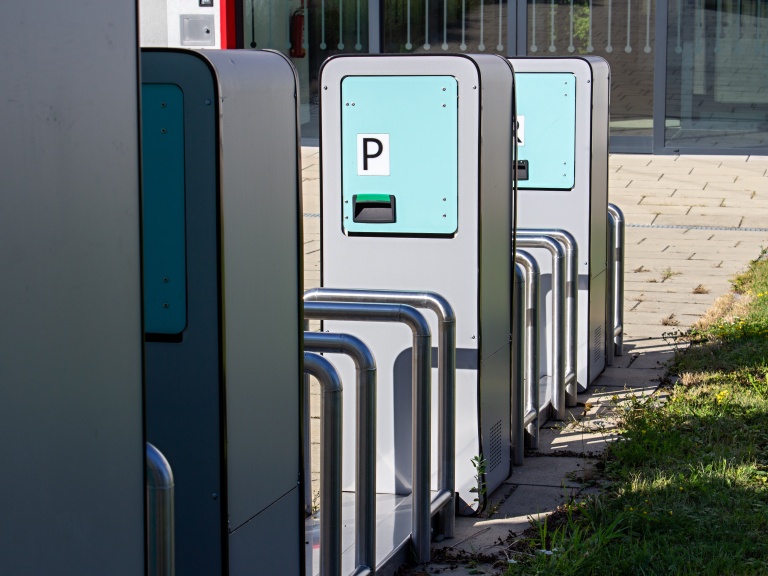By the end of next year, with support from the Technology Agency of the Czech Republic, they will focus on the development of a modular e-charging system for small electric vehicles in urban environments. Radim Hercik, the principal investigator from VSB-TUO, provided more details about the project, highlighting it as another example of successful cooperation within the Fraunhofer Innovation Platform at VSB-TUO.
What is the main focus of the project?
The project focuses on developing a modular, eco-friendly e-charging system specifically for small electric vehicles, e-motorcycles, and other urban mobility solutions. It addresses the issue of charging stations and their compatibility with small electric vehicles and e-bikes, with the aim of providing nodes not only for charging but also for safe parking. The project therefore includes the development of robust and aesthetically pleasing e-charging stations, a prototype e-vehicle for energy transport, support for standalone systems, an online platform for intelligent monitoring operational statuses, as well as public demonstrations in Saxony and Ostrava. We are creating a kind of demonstration ecosystem to show how e-mobility could work in future urban environment.
Why did you choose this topic, and why did you decide to cooperate with German colleagues?
We are building on previous work where our colleagues developed three charging stations now located on VSB-TUO campus, in Ostrava-Hrabůvka, and in Chemnitz, Germany. Our current project involves enhancing these stations by integrating new systems, protocols, and increasing battery storage. This project aligns with the concept of green cities and complements initiatives like the NewHeatIntegrated project, which focuses on innovations in thermal energy storage and exemplifies our collaboration with the Fraunhofer-Gesellschaft. Additionally, this project aims to strengthen our existing partnerships with scientists and companies in both the Czech Republic and Germany, further deepening these valuable connections.
What role will each partner play in the project?
At VSB-TUO, our focus will be mainly on battery monitoring for e-motorcycles and developing a mobile app for e-motorcycles diagnostics. We will collaborate with our German colleagues to integrate new protocols into charging stations, thereby expanding the e-mobility portfolio.
We are developing a new prototype of an e-motorcycle in collaboration with the Czech company FIBRES. While company mainly focuses on the mechanical aspects, we are handling the charging, battery management, and phone communication for motorcycle diagnostics. Our German partners are tasked with modifying the charging stations, including incorporating solar energy and shared energy solutions, and introducing new protocols. They are also collaborating with a commercial company to develop prototype parts using sheet metal forming technologies. These parts are intended to be used for the construction of prototype or small-series e-vehicles, e-motorcycles, etc., and they can also be used as covers for charging stations and other applications.
How big is the team at VSB-TUO dedicated to the project?
Currently, the team consists of six key staff members, with students gradually getting involved. The team may expand to a total of 10 to 12 people. It is a multidisciplinary team including experts in energy management and sensor technology, programming, mobile app development, and more. In the future, we may also need to include a colleague from the Faculty of Mechanical Engineering to assist with the design of a new prototype for a fully electric motorcycle.
The GUMES project is intended to support the growth of e-mobility. What do you think is the biggest obstacle to the broader adoption of e-mobility, and how is your project addressing it?
I consider the biggest challenge right now to be the availability of electric charging stations. Although their numbers are increasing, they are still insufficient to meet demand. Additionally, there are concerns about whether the distribution network can handle the increased load if a large number of vehicles are connected to the current charging stations. As I mentioned earlier, our project addresses this issue by focusing on updating data communication protocols to ensure they can serve not only electric cars but also smaller vehicles like e-scooters, e-motorcycles, and similar, allowing the entire system to better balance all energy flows.

How much financial support can you count on?
We secured funding through the DELTA II TA CR programme, which has provided a subsidy of approximately CZK 7.7 million for VSB-TUO. The total cost of the project for us is expected to reach CZK 8.3 million
Text: Martina Šaradínová, PR specialist for R&D
Photo: Viktorie Robenková